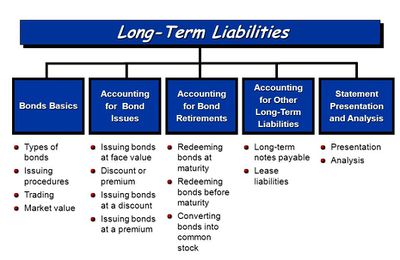Liability
A liability is a debt owed by a company that requires the entity to give up an economic benefit (cash, assets, etc.) to settle past transactions or events. A liability is typically an amount owed by a company to a supplier, bank, lender, or other provider of goods, services, or loans. Liabilities can be listed under accounts payable, and are credited in the double entry bookkeeping method of managing accounts. To settle a liability, a business must sell or hand over an economic benefit. An economic benefit can include cash, other company assets, or the fulfillment of a service.[1]
Liabilities are categorized as current or non-current depending on their temporality. They can include a future service owed to others; short- or long-term borrowing from banks, individuals, or other entities; or a previous transaction that has created an unsettled obligation. The most common liabilities are usually the largest like accounts payable and bonds payable. Most companies will have these two line items on their balance sheet, as they are part of ongoing current and long-term operations. Liabilities are a vital aspect of a company because they are used to finance operations and pay for large expansions. They can also make transactions between businesses more efficient. For example, in most cases, if a wine supplier sells a case of wine to a restaurant, it does not demand payment when it delivers the goods. Rather, it invoices the restaurant for the purchase to streamline the dropoff and make paying easier for the restaurant. The outstanding money that the restaurant owes to its wine supplier is considered a liability. In contrast, the wine supplier considers the money it is owed to be an asset.[2]
The relationship between liabilities and assets[3]
Assets are things a company owns. These include tangible items, such as equipment, machinery, buildings, and intangible items, such as interest owed, accounts receivable, intellectual property and patents.
If we subtract the company’s liabilities from its assets, we will get the owners’ or shareholders’ equity:
Assets – Liabilities = Shareholders' Equity
Generally, this fundamental accounting equation is presented as follows:
Liabilities + Shareholders’ Equity = Assets
Classification of Liabilities[4]
Liabilities are reported on a balance sheet and are usually divided into two categories:
- Current liabilities – these liabilities are reasonably expected to be liquidated within a year. They usually include payables such as wages, accounts, taxes, and accounts payable, unearned revenue when adjusting entries, portions of long-term bonds to be paid this year, short-term obligations (e.g. from purchase of equipment).OR' current liabilities are obligations whose liquidation is reasonably expected to require the use of current assets, the creation of other current liabilities, or the provision of services within the next year or operating cycle, whichever is longer.

source: ByJu's
- Long-term liabilities – these liabilities are reasonably expected not to be liquidated within a year. They usually include issued long-term bonds, notes payables, long-term leases, pension obligations, and long-term product warranties. Liabilities of uncertain value or timing are called provisions.

source: Coby Harmon
- ↑ Definition of a Liability Debitoor
- ↑ Explaining Liabilities Investopedia
- ↑ The relationship between liabilities and assets Capital.com
- ↑ Classification of Liabilities Wikipedia
